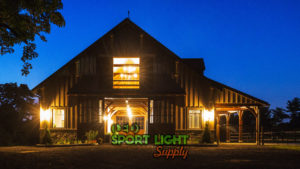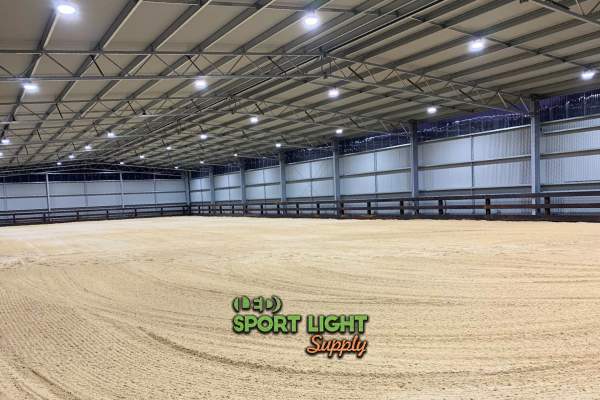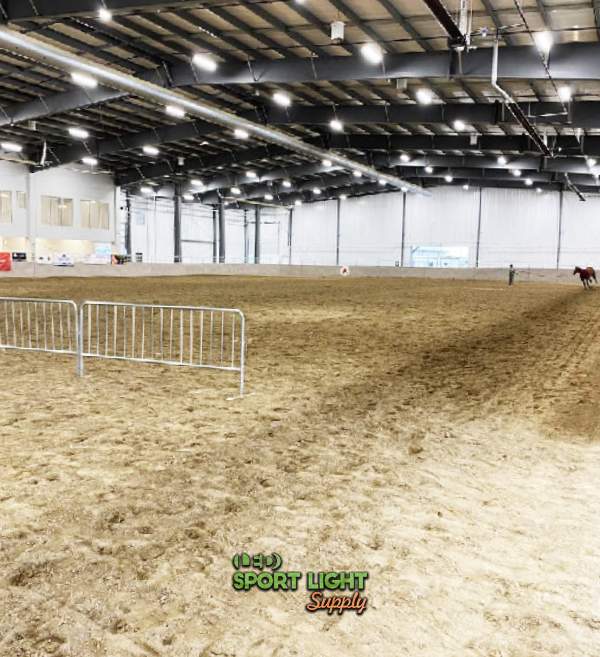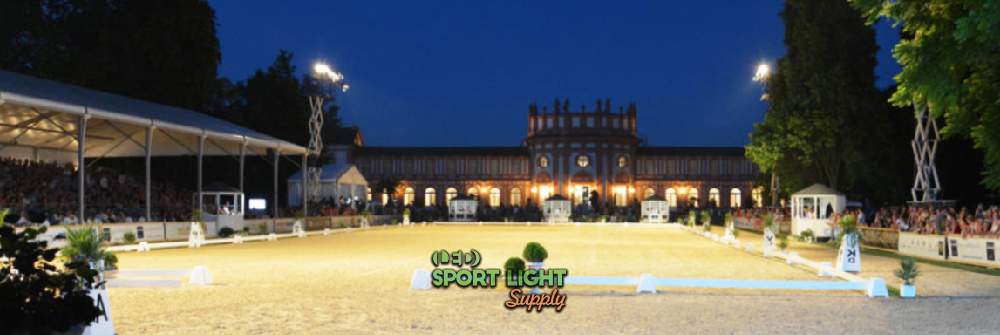
The right lighting not only enhances visibility but also minimizes shadows and glare, which can distract both riders and horses. We will discuss the best practices for lighting horse arenas, focusing on optimal light levels, uniformity, placement, and the advantages of using LED technology. It also addresses environmental considerations, maintenance requirements, and the longevity of lighting systems.
Table of Contents
Toggle| Type of Horse Arena | Recommended Lux Levels | Purpose |
|---|---|---|
| Recreational Arena | 200-300 lux | For casual riding, basic training, or leisure use. Focuses on general visibility and comfort. |
| Training Arena (Non-competitive) | 300-400 lux | For regular training sessions and lessons. Ensures better visibility and safety for riders. |
| Dressage Arena (Practice) | 400-500 lux | For precision training where visibility and uniformity are crucial for performance. |
| Jumping Arena (Practice) | 400-600 lux | Provides clear visibility of jumps and obstacles to enhance safety and accuracy. |
| Indoor Competition Arena | 500-750 lux | For official events and competitions. Ensures consistent lighting for judging and performance. |
| Outdoor Competition Arena | 500-800 lux | Accounts for varying natural light; requires higher lux to maintain consistent visibility. |
| Show Jumping Arena | 700-800 lux | High-intensity lighting for clear visibility of jumps during competitions. |
| Rodeo Arena | 750-1000 lux | Requires bright lighting for fast-paced events to ensure safety and clear visibility. |
| Equestrian Stadium (Major Events) | 1000+ lux | For large-scale events with spectators. Requires maximum illumination for visibility and broadcast quality. |
 Lighting levels in horse arenas significantly impact visibility and safety. Experts generally recommend that the illumination for indoor or outdoor horse arenas falls between 300 to 500 lux. This range ensures that the entire riding space is adequately lit, allowing both riders and horses to perform optimally. Maintaining this level of lighting helps in reducing the chances of accidents by enhancing visibility and depth perception. Additionally, it creates an environment that feels more natural and comfortable, contributing to a positive experience for users.
Lighting levels in horse arenas significantly impact visibility and safety. Experts generally recommend that the illumination for indoor or outdoor horse arenas falls between 300 to 500 lux. This range ensures that the entire riding space is adequately lit, allowing both riders and horses to perform optimally. Maintaining this level of lighting helps in reducing the chances of accidents by enhancing visibility and depth perception. Additionally, it creates an environment that feels more natural and comfortable, contributing to a positive experience for users.
Achieving consistent lighting across the arena is crucial for eliminating dark patches and overly bright spots. Inconsistent lighting can create shadows that may confuse horses and riders, potentially leading to missteps or hesitations. This is particularly significant during events or competitions where precision is critical. LED lights are especially suited for this purpose, as they provide a stable and uniform distribution of light without flickering. The even illumination offered by LEDs ensures a more reliable visual environment, which is essential for the focus and confidence of riders and their horses.
One of the standout benefits of LED technology is its energy efficiency. Compared to traditional lighting options such as incandescent or halogen bulbs, LEDs consume considerably less power while delivering the same, if not better, levels of illumination. This reduction in energy consumption translates to lower electricity bills, making LED lighting a cost-effective choice in the long term. Horse arena owners and managers can benefit from these savings, especially in large facilities where numerous lights are required to maintain adequate coverage.
Beyond cost savings, LEDs also have a positive impact on the environment due to their lower energy usage and reduced carbon footprint. With growing awareness of sustainable practices, many arena owners are shifting towards LED lighting solutions to align with green initiatives.
LED lights are designed to last significantly longer than traditional bulbs. The extended lifespan of LEDs minimizes the need for frequent replacements, which is particularly beneficial in horse arenas where fixtures are subject to high usage and variable conditions. This durability reduces maintenance efforts, allowing for uninterrupted lighting that supports the safety and performance of riders and horses.
Another benefit of LED lights is their resistance to shock and vibration. Horse arenas often experience vibrations from hoof impacts and other movements, and traditional lighting systems may suffer from early failure under such conditions. In contrast, LEDs are constructed to withstand these stresses, further extending their operational life.
In addition to being energy-efficient, LEDs emit very little heat compared to other types of bulbs. This characteristic is advantageous in horse arenas, especially during long training sessions or events where heat buildup can affect both horses and riders. By keeping the ambient temperature more stable, LEDs contribute to a more comfortable environment. This is particularly beneficial in enclosed indoor arenas, where excess heat from traditional lighting can quickly make the space uncomfortable.
 Proper placement of lighting fixtures is crucial to achieving effective illumination in a horse arena. To optimize light coverage, lights should be installed at a height of at least 4 to 6 meters above the arena floor. Mounting fixtures at this height ensures a broad distribution of light, reducing the risk of shadows and enhancing overall visibility. Proper height selection also helps avoid the risk of glare that can distract horses or riders during activities.
Proper placement of lighting fixtures is crucial to achieving effective illumination in a horse arena. To optimize light coverage, lights should be installed at a height of at least 4 to 6 meters above the arena floor. Mounting fixtures at this height ensures a broad distribution of light, reducing the risk of shadows and enhancing overall visibility. Proper height selection also helps avoid the risk of glare that can distract horses or riders during activities.
The angle at which lights are installed plays a significant role in ensuring even illumination. Fixtures should ideally be tilted slightly to reduce direct glare and enhance the uniformity of light distribution. This angled positioning helps to illuminate the arena floor without creating harsh light that can cause discomfort to riders or horses. In addition to angled fixtures, lights should be placed around the perimeter of the arena, with additional fixtures overhead if needed. This strategic arrangement ensures that every corner of the arena receives adequate lighting, eliminating dark spots that may affect performance.
LED lights are highly versatile in terms of beam angles and light spread. By selecting the appropriate beam angle, arena owners can adjust the coverage to meet specific requirements. Narrow beams are ideal for focusing light on particular areas, while wider beams help cover larger sections evenly. This customization is particularly beneficial in horse arenas where different activities may require varied lighting setups. For instance, a wider beam might be suitable for general training sessions, while a narrower focus may be preferred during competitive events.
Horse arenas, whether indoor or outdoor, are often exposed to harsh environmental conditions, including rain, wind, and dust. LED lighting systems are typically encased in durable housings that protect the internal components from these elements. This robust design ensures that the lights maintain their performance over time, even in challenging conditions. The resilience of LED fixtures makes them ideal for outdoor arenas where exposure to the elements is unavoidable.
LED lights are engineered to perform efficiently across a wide range of temperatures. Whether in hot summer conditions or during freezing winter nights, LEDs maintain their functionality without a drop in performance. This capability is particularly advantageous in horse arenas where temperature fluctuations can be significant. Riders and horses benefit from a consistently lit environment, regardless of the weather conditions, ensuring safety and visibility throughout the year.

One of the most appealing aspects of LED lighting systems is their low maintenance needs. Traditional lighting systems often require regular bulb replacements and maintenance checks due to shorter lifespans and susceptibility to damage. In contrast, LED lights have a much longer operational life, reducing the frequency of maintenance interventions. This is especially beneficial in horse arenas, where the height and placement of fixtures make maintenance a challenging task.
While LEDs require less maintenance, periodic inspections and cleaning are still necessary to ensure optimal performance. Over time, dust and debris can accumulate on the surface of the fixtures, potentially reducing their brightness and efficiency. Regular cleaning of the lights helps to preserve their luminous output and ensures that the arena remains brightly lit. Additionally, occasional checks of the lighting system can help identify any issues early, preventing unexpected failures during crucial events or training sessions.
Investing in a well-designed LED lighting system not only improves visibility but also enhances the overall experience for both horses and riders. By following best practices for lighting placement, beam customization, and maintenance, horse arena operators can create a safe, efficient, and comfortable environment for all users.
Drop us a line to receive a free lighting design